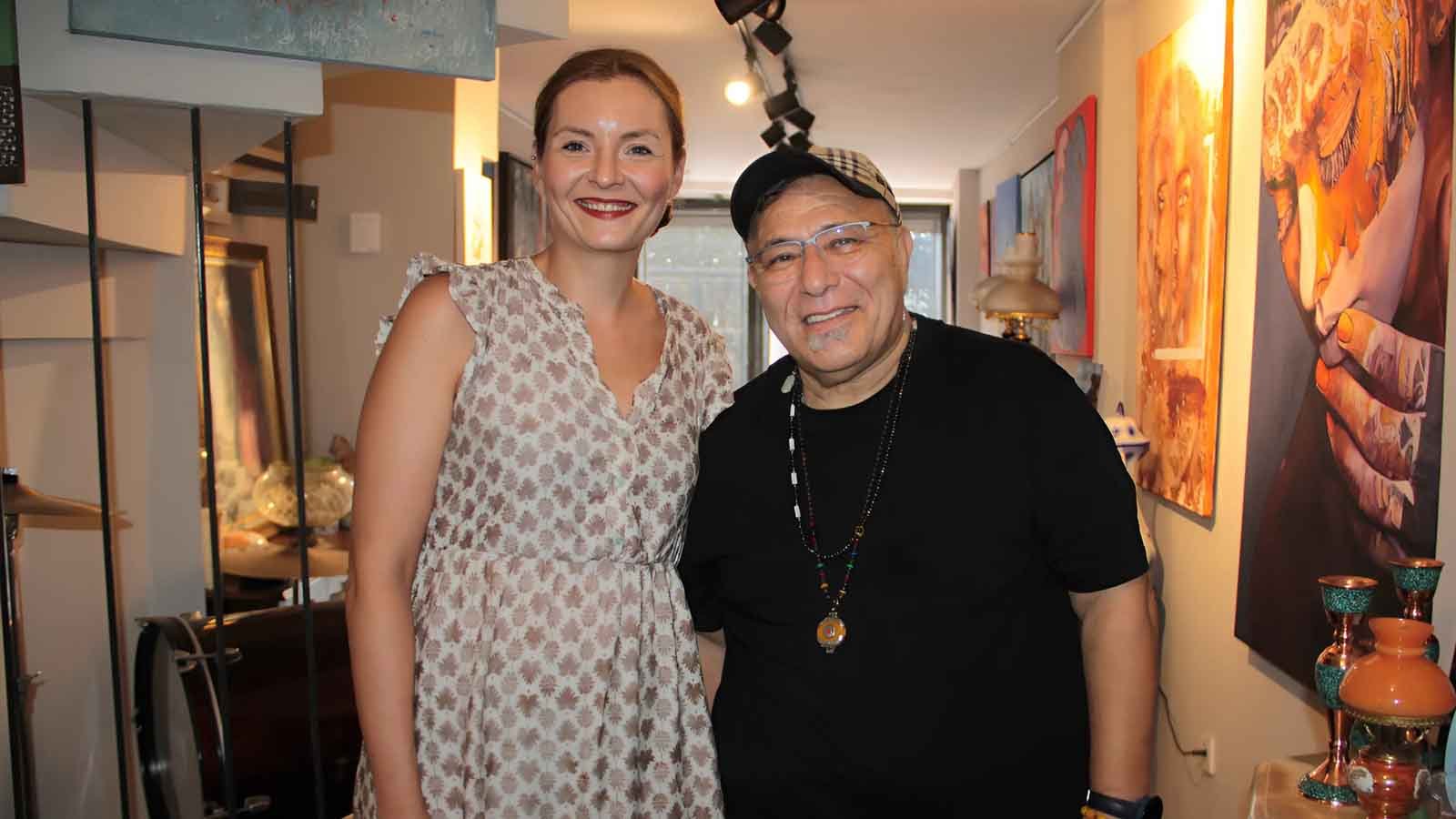Since June 2023, Caner Kemahlıoğlu has been showcasing the influences of Orientalist textures alongside special collection artists. After Sivas’ historic venues, the next stop was Tunceli’s historic museum. Shortly after, on September 26, they held the opening of new exhibitions with new works in Tokat, once again by special invitation. This time, Kemahlıoğlu explored the exhibition space as a modern art venue and brought it to art enthusiasts at Tokat’s Vera Culture and Art Center.
Curated by Caner Kemahlıoğlu, the exhibition features works prepared for a special artistic invitation, unveiling both the textures of the Orientalist approach and details from historical jewelry. The program presents artworks from various disciplines to its audience. Under the curatorial theme “Orientalist Inspiration: The Enchantment of Jewelry,” the exhibition features self-portraits interpreted by different artists from ancient history, while also aiming to present artists’ special stories through their artistic practices, offering a significant perspective.

Topkapı Palace’s 100th Anniversary: Time to Discover Our Historical Heritage
This year marks the 100th anniversary of Topkapı Palace, highlighting the importance of preserving our historical culture and traditions. Built between 1460 and 1478 by Sultan Mehmed the Conqueror after the conquest of Istanbul, the palace holds significant historical value. Over the years, successive sultans added structures to form its current layout. By the 1840s, the palace became insufficient to meet the demands of the 19th-century state protocol, leading to the construction of Dolmabahçe Palace between 1843 and 1856, which then became the main residence and administrative center for the Ottoman dynasty. Both palaces, situated between the Marmara Sea, the Bosphorus, and the Golden Horn, remain iconic symbols of Istanbul’s historical significance.
The exhibition brings history to life through surviving historical elements that reflect specific eras (such as palace jewelry, attire, etc.), blending Ottoman Orientalist tilework with architectural and decorative details. The staging and storytelling in the exhibition invite visitors on a historical exploration, presenting subtle connections between the past and present. Each century offers a unique journey through its artistic details.
For example, the art of tile-making, developed by the Karakhanids, was later advanced by other Turkish states. The art of tile reached its peak during the Ottoman Empire. It is evident today that the Great Seljuk Empire and the Anatolian Seljuks used tilework extensively in the construction of madrasas, mosques, and palaces. From the Seljuks to the Ottomans, the inclusion of tiles and ornamentations in various architectural structures helps revive forgotten aspects of history. Many tiles, with their geometric patterns, evoke the image of honeycombs, which symbolize the ecological balance represented by bees, a motif in human civilization since its inception. This ecological history is reflected in tilework, extending to the intricate hexagonal designs and ancient jewelry shaped like bees or insects, offering a glimpse into the symbolic language of these ornaments.

The Queen Bee in the Hive and the Jewel Crown: An Artistic Connection to Extinction Scenarios
Inspired by the queen bee, the largest and longest-living bee in the hive, this concept unveils frames of destruction scenarios that reflect various devastations across different eras. Symbolically, the queen bee represents power and leadership. In this artistic bridge, the concept of the crown connects to the queen bee’s crown, forming a foundation for the transition between bees and jewels. The symbolic hexagonal shape of honeycombs is linked to the patterns found in Seljuk and Ottoman-era tile decorations, creating an artistic connection. From this perspective, the underlying theme reveals that the extinction of one species could lead to the chain extinction of many others, including humans.
As the environment changes and the gene distributions of populations interact with shifting environmental conditions, balance points—like the environment itself—change unpredictably, leading toward chaotic extinction scenarios. What remains from these catastrophe scenarios are not the living beings, but their memories and the jewels they left behind.
“Jewelry is an ancient phenomenon dating back to when humans first began to dominate the earth. Aware of their powerlessness against nature, humans initially used jewelry as totems and later, with the discovery and processing of various metals and stones, began using it for different reasons and in diverse forms. Jewelry has always been a reflection of refined tastes, leading to the creation of magnificent pieces that have brought together artists from various disciplines. The Renaissance showcased jewelry as a mirror reflecting social progress and as a document of the artistic understanding of the era. The fashion trends, economic, and political reasons of the time left very few Renaissance jewels, the most striking examples of which can be seen in the paintings of jewelers-turned-painters from the period.” (Kılıçarslan Khodaei, 2023). The echoes of Renaissance jewelry, with its grand artistic details, reflect traces of the art developed in Medieval Europe, drawing attention to the brilliance of that period’s craftsmanship.

From the Renaissance to Neoclassicism: The Aesthetic and Symbolic Meanings of Jewelry Art
Every era has its own unique attitude and understanding of art. In valuable jewelry, this understanding embodies both aesthetic and symbolic meanings, adapting to the art of its time. In Renaissance jewelry, examples can be found where details reveal personal identities, professions, family ties, or social statuses. For instance, a coat of arms or surname on a ring indicated family lineage or nobility. A musical note or a paintbrush on an earring showcased artistic talent or interest in art. A sword or shield depicted soldiering or warrior spirit on a bracelet. Compared to their meanings in ancient times, such features are now rarely found in certain countries or are observed in the collections of art museums. When looking at the Renaissance period, the female portraits and jewelry details by Raffaello Sanzio and Alessandro Botticelli stand out. In the Neoclassicism period, Jacques-Louis David’s figures are noted for their elegance and intricate jewelry details. Every era certainly has small details, but it is particularly appropriate to highlight these periods in terms of meaning and intensity.

Discover the Power and History of Jewelry with Orientalist Touches
The arrangement of the exhibition allows for a progression of works from beginning to end, enabling the viewer to derive deep meanings from each piece through its elegant curation. With the opening of an Orientalist window, we set out to explore the history of jewelry, which is not only dazzling but also a symbol of power, seeking a blend of traditional and contemporary artistic emphases. Among the featured artists in the exhibition are Ahmet Kurt, Deniz Serkan Özcan, Derya Aysun Cancan, Ebru Yolver, Feruze Ulaştepe, Fırat Bahşi, Gülşah Tontu Özdemir, Günsu Saraçoğlu, Muhammet Hızır Yüksel, Nurhan Yıldırım, Okan Karakaya, Serdar Alp Erçin, Sinan Aslan, Suzan Mahmutoğlu, and Şerife Meral Eşmeler. Kemahlıoğlu will be adding new names to this collection in the upcoming period. Among the most prominent pieces in Kemahlıoğlu’s manifesto are “Portraits of Women by Alessandro Botticelli” by Ahmet Kurt and “Princess Broglie by Jean Auguste Dominique Ingres” by Muhammet Hızır Yüksel, which reflect traces of history. This special invitation, featuring exclusive works, opened at Vera and is one that collectors should keep on their radar.

The curator has taken a special approach to the 100th anniversary of Topkapı Palace by selecting certain pieces that reflect the museum’s characteristics. Notable contributions include Şerife Meral Eşmeler’ works featuring the significant yali (waterfront mansions) of the Istanbul Bosphorus alongside Topkapı Palace tiles, Sinan Aslan’s creations that showcase digital and unique jewelry details, and Deniz Serkan Özcan’s new interpretation of the Kasıkçı Diamond. With a different perspective, Günsu Saraçoğlu presented the culture of hammams through an Orientalist approach using ostrich eggs, while Gülşah Tontu Özdemir showcased her jewelry work with a focus on punctuation. Ebru Yolver exhibited her jewelry designs as well. The progression of the exhibition entirely captivated the audience in an Orientalist spell as they explored the space.




























